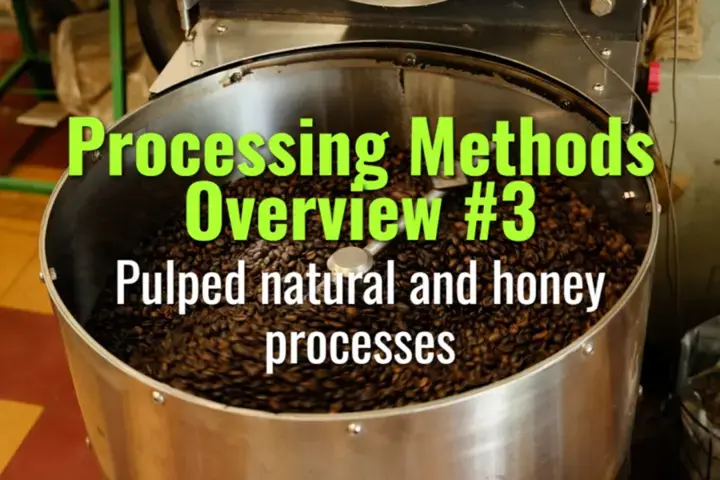Pulped natural and honey processes
This topic explains the pulped natural and honey processing methods—hybrids of washed and natural approaches—highlighting their steps, flavor outcomes, and significance in specialty coffee.
- Coffee Basics Nerds
- 2 min read
Article 3 of 12 in Processing Methods Overview/

What are Pulped Natural and Honey Processes?
- Hybrid methods between washed (wet) and natural (dry) processing.
- Pulped natural: Common in Brazil; skin removed but mucilage left on beans during drying.
- Honey process: Similar, but more widely used in Central America; degree of mucilage left determines flavor outcome.
Key Steps
1. Harvesting & Sorting
- Ripe cherries hand-picked for quality.
- Floats removed to eliminate defects.
2. Pulping
- Cherries pulped to remove skin.
- Unlike washed process, mucilage is not fully fermented or washed off.
3. Drying
- Beans dried with mucilage still attached.
- Spread on patios or raised beds, turned regularly to prevent over-fermentation.
- Drying time: 2–4 weeks depending on mucilage amount and climate.
4. Honey Process Variations
- Yellow honey: Small amount of mucilage left, lighter, cleaner profile.
- Red honey: Medium mucilage, sweeter and fruitier.
- Black honey: Most mucilage left, intense fruit and heavy body, riskier to manage.
Sensory Outcomes
- Pulped natural: Balanced profile—cleaner than naturals, sweeter than washed.
- Honey process: Wide range depending on mucilage level:
- Yellow: Bright, balanced.
- Red: Sweet, fruity, syrupy.
- Black: Intense, winey, heavy-bodied.
- General traits: Enhanced sweetness, medium acidity, syrupy mouthfeel.
Advantages
- Lower water use compared to washed processing.
- Distinct cup profiles attractive to specialty buyers.
- Allows producers to diversify offerings from the same farm.
Challenges
- Requires careful drying management to avoid mold or over-fermentation.
- More labor-intensive than fully washed systems.
- Quality consistency depends on climate control and farmer expertise.
Regional Use
- Brazil: Pulped natural widely practiced at scale.
- Costa Rica, Honduras, El Salvador, Nicaragua: Honey processes highly popular in specialty markets.
Lasting Importance
Pulped natural and honey processes represent innovation through adaptation—balancing resource efficiency with flavor diversity. They allow farmers to create unique, marketable profiles while reducing water use, making them a cornerstone of modern specialty coffee.
You might also like:
- Tags:
- Lasting Importance
- Specialty Coffee
- Specialty Markets
- Specialty Buyers
- Labor Intensive
- Raised Beds
- Central America
- Sensory Outcomes
- Widely Used
- Cup Profiles
- Challenges Requires
- Requires Careful
- Black Honey
- Washed Processing
- Heavy Body
- Pulped Natural
- Natural Honey
- Honey Processes
- Beans Dried
- Ripe Cherries
- El Salvador
- Quality Consistency
- Red Honey
- Costa Rica
- Yellow Honey
- Drying Beans
- Modern Specialty
- Regularly Prevent
- Dry Processing
- Climate Control
- Flavor Diversity
- Hybrid Methods